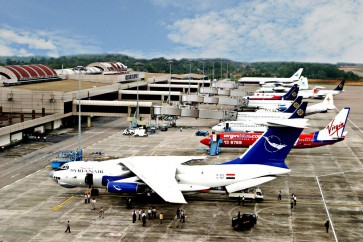Popular Reads
Top Results
Can't find what you're looking for?
View all search resultsPopular Reads
Top Results
Can't find what you're looking for?
View all search resultsReduce urbanization
In February 2007, the worst flooding in Jakarta's history inundated about 70 percent of the city, killed at least 57 people and sent about 450,000 fleeing their homes
Change text size
Gift Premium Articles
to Anyone
In February 2007, the worst flooding in Jakarta's history inundated about 70 percent of the city, killed at least 57 people and sent about 450,000 fleeing their homes. Almost exactly a year later, floods hit Jakarta again. This clearly indicates that flooding is an annual event in Jakarta. Fortunately, the extent of this year's flooding was not as great as in 2007.
Hours of heavy rain in Jakarta caused most of the main roads in the capital to be submerged in knee-deep water, bringing traffic to a near standstill. Thirty-seven of 267 subdistricts in Jakarta were inundated by more than 40 centimeters of water. Floodwaters caused public transportation, including the busway lines across Jakarta, to stop operations, leaving thousands of passengers stranded.
One of the major impacts of this year's flooding was the inundation of the Sedyatmo toll road to Soekarno-Hatta International Airport, which resulted in the cutting off the highway for a few days. Nearly 1,000 flights were delayed or diverted and 259 flights were canceled. The monetary losses from these delays and cancellations could reach billions of rupiah.
The Indonesia National Air Carriers Association said the loss was about Rp 40 million for each hour an airplane was stranded. The loss is greater for flights that were diverted to other airports due to the additional costs for the fuel, ground handling, navigation charge and airport charge.
The poor drainage system was blamed as the primary cause of this year's floods, as claimed by Basah Hernowo, the director of forestry and water resource conservation at the National Development Planning Board (Bappenas), and Pitoyo Subandrio, the head of the Ciliwung-Cisadane Flood Bureau (The Jakarta Post, Feb. 2).
This year's flooding was due to local heavy rainfall, and was not combined with rain on the outskirts of Jakarta. Last year, then governor Sutiyoso blamed deforestation and overbuilding in neighboring areas that were supposed to be water catchment areas for the floods. This year such blame is not present. However, the threat of neighboring areas causing severe floods in Jakarta is still present.
The annual floods in Jakarta are strong evidence that Jakarta has not been able to sustainably accommodate its growth. Two centuries ago, the Dutch colonial government, with its long experience in controlling water and drainage systems, built a canal system to protect the city's population which was then 500,000.
Jakarta, which lies in a lowland area with 43 lakes and 13 rivers, relies on the canal system to prevent flooding. Today, Jakarta is a megacity with a population of nearly 10 million within the city's boundaries and more than four million in neighboring areas; yet, it still relies on the same canal system to avert flooding.
Not only is Jakarta the capital of Indonesia, it is also the economic, commercial, cultural and transportation hub of the nation. Jakarta is the prime city of Indonesia and it dominates the urban system. The population of Jakarta is poised to grow faster than other parts of Indonesia.
The annual floods also demonstrate how growth in Jakarta confronts private consumption and public investment in infrastructure. The Indonesian economy has grown at a robust pace of 6 percent a year and Jakarta has been Indonesia's primary growth machine. New homes, commercial and office buildings have proliferated in Jakarta and its neighboring areas, but hardly any new infrastructure, including the expansion of Jakarta's canal system, has been built in the past 10 years since the economic crisis hit Indonesia in 1997.
Neither improving the drainage system nor dredging the canals and rivers is a sustainable solution for the annual floods in Jakarta. The annual floods are strong evidence that rapid urbanization in Jakarta must be reduced. One way to reduce the rapid urbanization is to eliminate the pull factor of urbanization.
One major pull factor of urbanization in Jakarta is its function as the economic, commercial, cultural and transportation hub of the nation, as well as the capital of the country. Indonesia needs to redistribute the central functions from Jakarta to other parts of the nation and create more urban agglomerations to pull urbanization away from Jakarta. Relocating central functions out of Jakarta will not only make Jakarta more sustainable, but also create regional equality in Indonesia.
The writer is an assistant professor of urban studies at Savannah State University in the U.S. He can be reached at rukmanad@savstate.edu.










